When we started these Short List interviews on S/W, back in March 2019, with Oscar Hudson, the idea was always that they would be a series of articles offering insight into some of the most exciting new filmmaking talent emerging from the world of short film. While this has always remained the case, they’ve also organically transformed into a chain of interviews with filmmakers who are taking the next step in their career – almost becoming a ‘How-to’ guide for directors looking to move on from short film.
I’ve always been a firm believer that short film is not just a stepping stone for directors aiming for “bigger” (or should that be longer?) things, but as S/W gets older and our catalogue of featured directors increases, we’re regularly seeing our filmmakers experience more of this “traditional” mainstream success – as is the case with our latest Short List interviewee Elizabeth Lo.
Previously featured on S/W with Hotel 22 and Mother’s Day, Lo has had an industrious output since we first featured her work back in 2015 and has added another six shorts to her IMDB page after her impressive Stanford University film. Catching our eye with her detached, verité approach, on show in Hotel 22, before impressing again with the subtle and restrained filmmaking in Mother’s Day, Lo cemented her place as one of the most exciting new voices in the world of documentary shorts.
The next natural step in her career was into features and we’re excited to say that’s exactly what happened. In production for the last couple of years, Lo’s debut feature Stray has been making a splash on the festival scene in 2020, playing Tribeca, BFI London and winning the Best International Feature Award at Hot Docs. Now with a Critics Choice nomination for Best First Documentary Feature and the film set for distribution in early 2021, we took the opportunity to talk to Lo and find out how her work in short film has helped with the transition into features.
Hi Elizabeth, thanks for joining us today. As someone who has followed your work for the last couple of years and been a big fan of your filmmaking, I was excited to see your debut feature Stray as part of the London Film Festival this year. I wanted to talk about that film today, and obviously, your progression from short to feature, but for a lot of our audience, they won’t have seen Stray yet, can you introduce it to our audience? How would you describe your film?
Sure…Stray is a film that follows a stray dog called Zeytin and her companions, both human and non-human, as she makes a living on the streets of Istanbul. It’s all about the conversations and human drama that she eavesdrops on and leaves behind, it’s the story of a city told through a dog’s perspective.
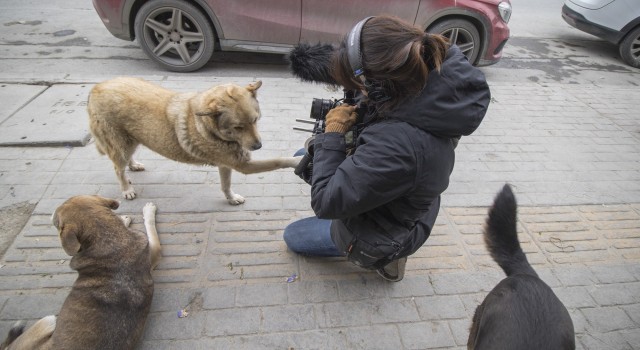
Lo’s debut feature Stray sees her take to the streets of Instanbul to follow the city’s stray dogs
I think that sums the film up nicely. I watched it recently and I was really impressed and quite moved, by how you manage to portray life in this city by following these dogs. The little conversations you get to eavesdrop on and lives you get a glimpse of make it a really heartfelt film.
The story is new, but the approach to filmmaking feels familiar from your shorts. With that in mind, I guess the next question I want to ask is when did you decide that you wanted to make a feature? Was it always in your plans when you started making shorts that you knew you wanted to progress to making features, or did you only consider it after you’d already made a few shorts?
I guess I never actually really thought about it. I knew I wanted to be a filmmaker and I never really gave much thought to the length of the films I was making, but shorts obviously felt like the natural place to start. I think it was five years ago, after having made Hotel 22 and Bisonhead, their success sort of exposed me to the world of independent film and it felt like that was the time to challenge myself more and to tell a story over an hour and not over 10 minutes.
That’s after graduating from my masters film program at Stanford. I had been making shorts for over 10 years, from undergraduate to graduate school to working as a director, and I felt like a feature was a challenge I really wanted to pursue at that stage in my journey.
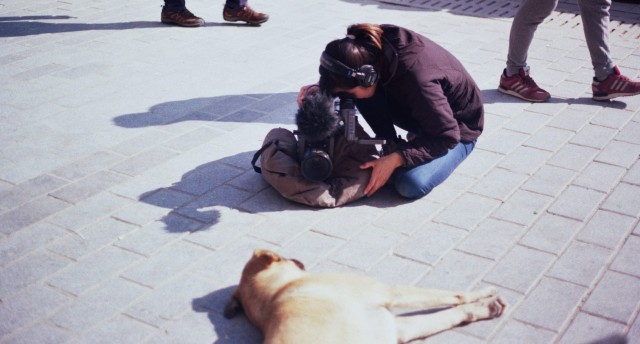
“Making the feature was a much more spontaneous process” – Lo on the difference between making her feature and her short films.
You never started making shorts because you wanted to transition into features, it wasn’t like that?
I didn’t think about it like that. It felt like shorts was this way for you to make films where you have total creative control because the stakes and the budgets are lower, and I think that was really the only way to make a film at that point.
As you mentioned, you’ve been quite prolific in short film output, so with that experience in mind, let’s talk about the difference in preparation between making your shorts and making your feature. What changes when you’re preparing to shoot and make a feature from when you’re making your short films? Did your approach differ at all?
It did. Especially, I think, because this was a foreign project, it was taking place outside of my own home country and it was the first time I was doing anything outside of the United States. I had to work with people who were more familiar with Turkey and who lived in Istanbul and who spoke the language. I think it was a much more collaborative process in a way, I had to quickly learn to be more collaborative and to rely on the expertise of other people.
“In a strange way, making the feature was a much more spontaneous process”
In terms of pre-production, I guess with a short, I felt more decisive in a way. Like when I made Hotel 22 or Mother’s Day, I was very clear about exactly what the film might look like or how it would be because you’re just conceptualizing 10 minutes. But with Stray, it was always very nebulous in my mind, even before going out to Turkey for the first time.
I had no real idea of what the film would be like and who we would meet because I didn’t have the opportunity to scout beforehand, in the way that I did with my shorts. So, it was much more spontaneous. In a strange way, making the feature was a much more spontaneous process because it was not self-contained. It involved collaboration, it involved travel and going to unknown places. In a way that my shorts felt much more under my control, the feature wasn’t.
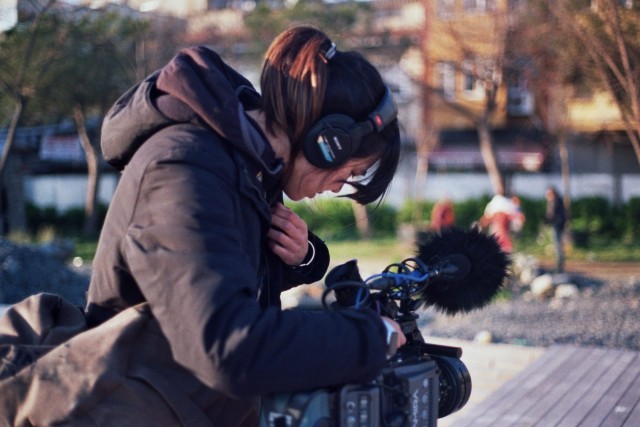
Lo used her own money to go out to Istanbul and try to get a sample reel together to show to potential funders.
I’m guessing one of the things that’s different with a feature is funding. I assume that with a longer project, a bigger project, you need more money. I know from watching the film and its credits, you had a few different funding partners attached to Stray. Could you tell us a little bit about how you went about getting funding for the film?
Originally, when I first came up with this idea in 2015, it was focused on stray dogs around the world and it was a difficult pitch to try to raise money for because the storylines weren’t clear. So, for two years after graduating, I already knew I wanted to make this film and I was applying to all the grants and not getting a positive response.
In that time, because of the success of Hotel 22, I had the opportunity to direct and work on all these funded, commissioned and commercial shorts. Then with that capital finally, after two years, I decided I’m just going to use my own savings and go out to Istanbul and try to get a sample reel together that would hopefully be able to bring supporters on board. That’s what ended up happening.
“We had considered just turning our sample footage into a short”
We went out to Istanbul, for the first scouting shoot trip, just on my own money. Then when we came back with the sample footage, we were able to get the support of Rooftop Films and their equipment grant. Which was actually what propelled us, from there we also got meetings at IFP Film Week and grants from ARRI AMIRA for camera. Getting those opportunities is what drove me to take on the bulk of the production, for six months in Instanbul – which was in 2018.
Prior to that, there was actually a time when we hadn’t been hearing back from people about whether they wanted to support the film or not. At that point, we had considered just turning our sample footage into a short. I was actually very reconciled to doing that. Then we finally got some positive responses and I’m now really glad we had that kind of support. It pushed me to go out and fulfil the original vision I had, to take up far more time than I have ever allowed myself as a filmmaker, and for my protagonist than I had in my shorts.
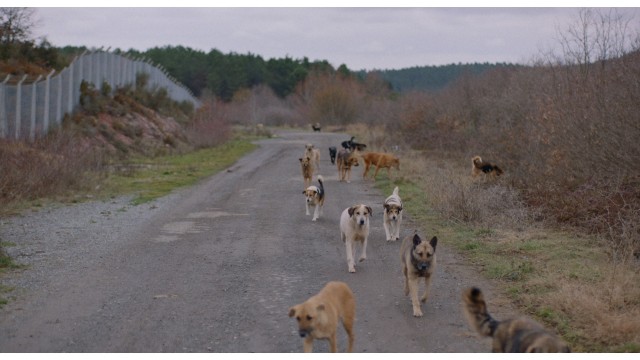
“It’s an obscure topic that nobody cares about” – feedback from a funder when Lo was trying to find financing for her feature
It’s interesting you mention that Stray was a difficult film to pitch. I’m not a filmmaker myself, but I have some insight into the filmmaking process and it couldn’t help cross my mind when I was watching the film – I was thinking, “how did she sell this to financers?” With your experiences of acquiring funding for this film still quite fresh, would you have any advice to filmmakers in terms of selling their ideas and getting finances? How do you go about getting someone to believe in your project? That’s quite the question, I know!
With this film, I feel very pleased that we were able to sell the film to Magnolia and we’ve been selling it through Dogwoof around the world to different territories. That’s been very gratifying because we’ve made back the money that we’ve personally put in. It was a difficult film to pitch and sell. I remember one of the things that a funder once told me:
“You have a threefold problem”, he declared. “First of all, it’s an obscure topic that nobody cares about, stray dogs are probably going to outlive us all, they’re not like an endangered species or anything. Secondly, you have a very obscure take on an obscure topic”, because I was saying that the stray dogs should be allowed to roam freely. Then he concluded by explaining that “those two problems combined mean you have very tough pitch”.
“Just because a film is difficult to put into words, it doesn’t make them less worthy of getting made”
In terms of advice for filmmakers, especially for a first film, if you can take on lots of roles and hone your craft, like I shot, edited and directed Stray and also played a big part in producing it, you drastically cut down your costs. Also, I often feel like just because a film is difficult to put into words, it doesn’t make them less worthy of getting made, just because they’re hard to articulate. Sometimes I even think those are the kinds of films that should get some more support because they’re fitting into the medium that goes beyond words.
But I’ve also learned that, and this is something I wish I had known earlier, a lot of filmmakers hire professional grant writers to help them articulate their vision and speak the language needed to get other people on board. That’s something I wish I had known when I was writing the writing grants myself, because how do you compete with someone who has spent a decade honing that craft of being able to articulate in the way that you’re expected to?
You mentioned that you shot some sample footage, how important did that end up in getting the feature made?
Oh, so important. Prior to that, there was no interest and no support for the film. But once we came back with the sample footage, that presented people with a vision of what I wasn’t able to articulate on paper, that’s when we got the support from Rooftop, BAVC National MediaMaker Fellowship and ARRI ALEXA and all these different labs.
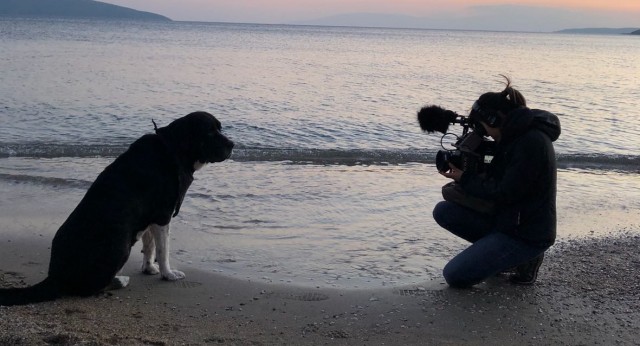
“The camera is such an important part of the making of the film and finding the voice” – Lo shot, edited and directed Stray herself
That’s really interesting to know. At S/W we’re familiar with hearing about these kinds of proof-of-concept films, but you always think of them associated with sci-fi or horror. It’s refreshing to know they work in the documentary field as well.
One of the things you mentioned here, and one of the things I’m really interested in, as I feel like it comes from your short film-making, is that you’re quite a hands-on filmmaker. I was looking through the credits for Stray earlier and it’s pretty much all you, you are the credits! What I was though, is what it is about this hands-on approach that really appeals to you? Is there something about that having total control that appeals to you in your filmmaking?
I think that’s what draws me to documentary, that it is this medium that doesn’t necessarily require huge crews. Also, I feel like because of the mode of filmmaking I was engaged in, in Stray and also Hotel 22 and all my other films, it was very much observational and I’m very much reacting to what’s happening around me, rather than directing. So the camera is such an important part of the making of the film and finding the voice, that taking on that role felt really important to me.
“It was such a sort of idiosyncratic vision I had for this film, being the editor was really important”
With a very non-linear film, like Stray, I think being the editor was also very important. It was a real challenge figuring out how to sustain attention and how to create a story out of a subject matter that is kind of timeless. The dogs, their lives are mundane. There’s not a lot of dramatic change happening. I felt like because it was such a sort of idiosyncratic vision I had for this film, being the editor was really important.
Although I might rethink this approach for future projects because I think there’s a lot to be said for collaboration and working with people who are better than you at shooting, better than you at editing and producing and can elevate your work. But for this film, this first film, I feel very gratified that this film is truly an expression of what I wanted the film to be.
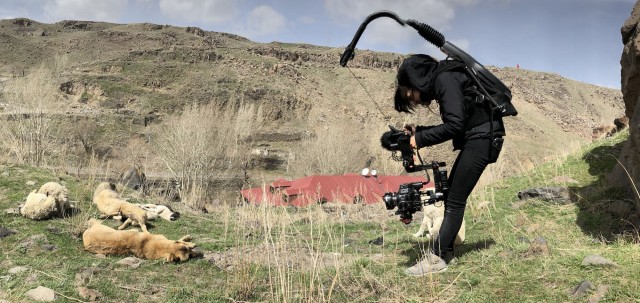
“Over the filming of six months, I felt like my body just slowly adapted to the rig” – Lo on the physical demands of shooting Stray
A little bit off-topic now, but how was the shooting? As a person who suffers with a bad back, I couldn’t help but think “oh, how is this poor cameraperson’s back after shooting this film?” – I didn’t know it was you at the time, but it must have been demanding to film? As it feels like you’re constantly at ground level with these dogs.
It’s all relative labor of course, but it did feel quite back-breaking when I was out there shooting it. I remember there were days when I would turn to one of my co-producers, Ceylan or Zeynep, and we’d be chasing these dogs around and they’d be going nowhere. They have no jobs, they’re not doing anything. We’d be like, “What are we doing with our lives? Toiling with this camera and following these subjects, they don’t care about our story, they don’t care about our film.”
“You see that a lot of those bumps in the footage, the struggle”
But yeah, there were points in the production where it was really difficult. Over the six months of filming though, I felt like my body just slowly adapted to the rig, to the weight, to the rhythm of the dogs, how they moved. At first, it was very frustrating because they would smell or hear something that I wasn’t aware of and they’d just dart off and I wouldn’t be able to keep up. But slowly, I was able to sort of read them more and prepare myself more physically as I crouched low or chased after them. You see that a lot of those bumps in the footage, the struggle.
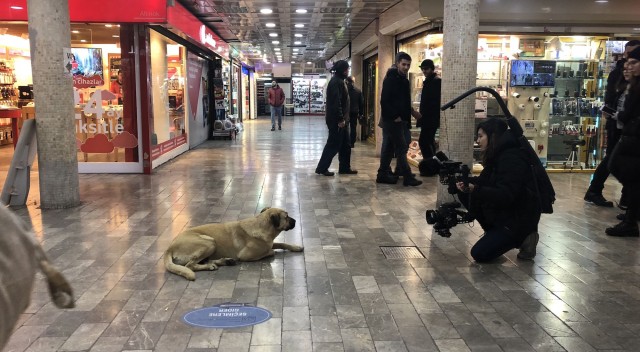
“People’s guards seem to come down and that was what allowed us to capture those really intimate political or romantic conversations” – Lo on including the public in Stray
How did you deal with the general public? Again, that’s one of the things I found really interesting in Stray, it never felt there was any attempt to tell them – “don’t look at the camera” – or wait for them to move on. It’s almost like they were invited to be part of the film if they wanted to be. If they didn’t, they could just walk away. Was that always in your mind?
It was a really interesting experience for me because I was very obviously an outsider to Turkish society. Also, because of the subject matter, I was following these dogs, I think the dogs combined with me not understanding the language, somehow, people’s guards seem to come down and that was what allowed us to capture those really intimate political or romantic conversations that were happening. I feel because the film was about dogs, which feels very innocuous, and because I literally couldn’t understand what they were saying, people allowed us in.
“I really loved that about the process, that people would pay attention”
I also think for them, and my co-producer Ceylan has mentioned this, in Turkish society, stray dogs roaming around is a given. Even though it’s this right that they fought for over so many years, for them, it’s a part of their civilization almost. But for me, as someone who grew up in Hong Kong and also has lived for a long time in the States, it’s such a rarity to see dogs living in this free way.
So I think my fascination with the dogs as a filmmaker, for them as a citizen it was a curiosity that I should pay so much attention to these animals that are just so integrated into their lives. But I really loved that about the process, that people would pay attention based on our differing cultural assumptions about what life in a city can look like.
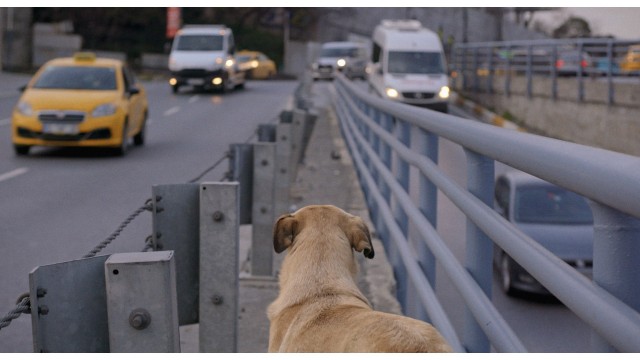
Like her short films, Stray operates within a tight runtime – only 73-minutes, which is very short for a feature nowadays.
Yeah, that’s great and it really added an extra depth to the film for me. To go back to your shorts for a minute though, one of the things I always really loved about your filmmaking was the fact that you always managed to tell a story in such a tight runtime.
I was looking over your shorts before I talked to you today and they’re all under 10 minutes. You get these great stories, these great personal interactions in such a tight run time, and it felt the same with your feature – which comes in at just over 70-minutes.
For a feature, especially nowadays, this is quite short. People have come to expect a feature to be pushing two hours and I always really enjoy it when it feels like a film has been put together with no restrictions or no targets that it has to meet. Was this the case with Stray? Were there any restrictions/demands on the duration of the film?
That’s really nice to hear that the film felt short to you, because I’ve read quite a few small remarks from little reviews of the film that are like – “This felt like a really long film” or “It’s just 72 minutes?”
“I wanted to give myself room to be indulgent with time”
I’m very aware that the shorts I’ve made are very succinct, I’m very ruthless in my approach as an editor on those films. For me, as a filmmaker, even though it is relatively short for a feature, it was a really long piece of film. When I set out to make it, I wanted to give myself room to be indulgent with time and with my protagonist in a way that I never was in my shorts.
There were people who would complain to me about how the shorts were too short or felt like we had too little time with the people in them, and so this was kind of a response to that. But I think the same ruthlessness I had as an editor in those films is still somehow transposed to my work as a feature director because you can see the length is still relatively brief.
Do you set yourself targets when you make films? With your shorts and with the feature, did you have any set goals in mind when it came to duration?
No, I don’t do that. When I’m watching my films, and maybe it’s a flaw with how short or how long they are, when I watch it, I try to engage with it as a person who has no interest in this story and no interest in the people in the film. I think about how it comes across to these people and how you get them to engage with the subject matter. How long do you have their attention for?
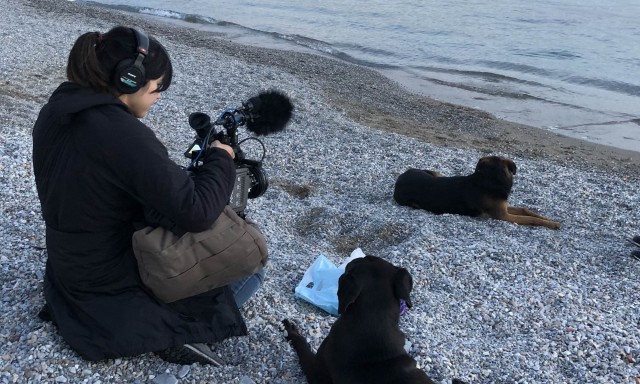
For a film like Stray, which Lo describes as “immersive and requires patience”, festivals are an essential way to find an audience.
For me, it’s definitely not a flaw. One of the things I love about shorts is the fact that you can get a similar emotional response as you would from a feature, but in a fraction of the time. It definitely feels that’s the way with your work.
With Stray, it’s spent most of 2020 in the festival circuit – a strange year for festivals – and I saw the film as part of the BFI London Film Festival. How important is festival recognition for you as a filmmaker?
It’s very important for me. In the world of independent film, even as a consumer or watcher of films, I rely on the gatekeepers of festivals, as their lineups tell me what is most worth watching this year. Even though those programs can exclude films that are really important or just don’t happen to fit into the taste of the programmers or the blinders that programmers have.
If you don’t have distribution or if your film doesn’t have commercial potential in the eyes of the huge corporations, then festivals are your way of getting your film seen. So, for me, with a film like Stray that’s immersive and requires patience and is striving to be a creative documentary, the audience for that is already niche and a festival can provide that.
Festivals have been really important in my career and I hope many survive this pandemic.
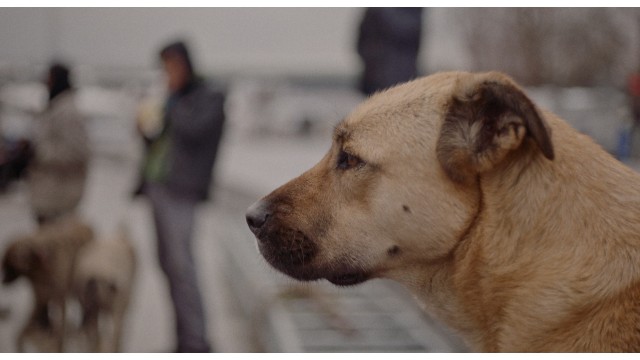
Lo admits it’s somewhat of a fantasy of hers to see Zeytin’s – her film’s star – face on the big screen
Me too. I know your short films from seeing them online, but did they have good festival runs? Were festivals important in the success of your short films as well?
Completely. With all my shorts I tried to get them into as many festivals as possible because as an emerging filmmaker, it allowed me to meet people who are in different facets of the film industry and they have helped to promote my work at this stage too.
Had it not been for the physical meetings, with different people – filmmakers, programmers, industry people – in the film world, through festivals, I don’t know how one would do it. It’s a great sadness that all of that is gone for the next year or two.
It’s very sad and it must have been hard not getting to see Stray with an audience and witness that physical reaction to it?
It’s been a long time in the making and it’s so surreal to think that I have yet to see this film with an audience. One of the fantasies I always had was to see Zeytin, the stray dog in Stray, to see her face occupy a 10-foot or 15-foot screen, to me that would be so grand.
“That’s always been my fantasy and I would love for that to still happen someday”
To have someone like her, who you would never expect to become the star of a film be seen by so many people in a theater and have everyone just paying attention to her, every move on her face. That’s always been my fantasy and I would love for that to still happen someday, but it feels like it’s a very distant future.
Hopefully, it will still be a possibility.
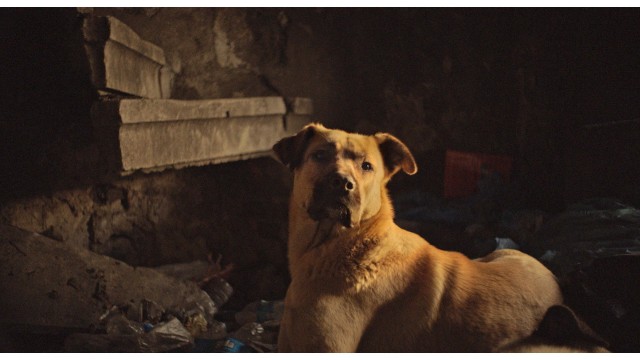
Stray will be released in March 2021 – hopefully with a theatrical and VoD release.
I really hope so. Speaking of the future, what’s next for Stray? Do you have more festivals lined up? And what about distribution, is that going to happen? Will people be able to see Stray in theaters maybe, or on VOD at least?
Next, it’s participating in Winner’s Circle at DOC NYC and then it’s part of the IDA Screening Series, before playing at IDFA in their Best of Fest, and then San Francisco Doc Stories. Magnolia Pictures bought the film, and also Dogwoof in the UK is distributing the film in March 2021.
It’s supposed to be a theatrical release, but we’ll see whether it’s virtual or theatrical or a combination of the two. I’m very excited and feel very fortunate that we were able to get distribution.
How was the distribution process? How did you go about finding Magnolia?
Three years ago, when I was pitching the film with that sample footage at IFP Film Week, that’s when I came across Oli Harbottle of Dogwoof, and he had kept in touch with me over a few years. Then, when we got into Tribeca, Dogwoof came on board as our sales agent and they brought on a publicist who got trade reviews for the film, which I think helped get interest from buyers like Magnolia.
When Magnolia came on board, Dogwoof helped to negotiate that deal. And Dogwoof has continued to sell the film in different territories, like Taiwan, Australia, and Scandinavia. We’ve been very fortunate to have them behind us, especially in this time when we’re not able to make the connections ourselves without preexisting relationships.
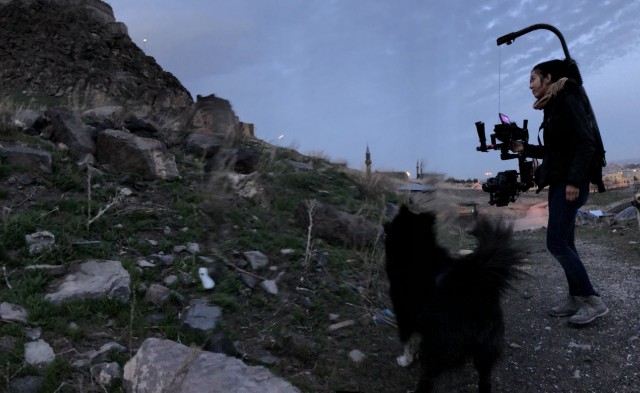
When we spoke, over Zoom, Lo was in Hong Kong preparing to work on her second feature.
Sounds like a great relationship. Well, thanks for joining us to talk about Stray today Elizabeth, everyone at S/W is excited by your move into features and the team are excited to see the film when they get the chance – hopefully on a big screen! Before we finish, any new projects you’re working on? What’s next for you?
I’m working on my second feature film. I’m currently in Hong Kong and hopefully pursuing my next project, which will take place in China. I had always wanted to make a film in China, but now more than ever, because of the pandemic. I’m just waiting to see if it’s even ethical to make films where COVID is too rampant and you don’t have the budget for testing your crew every day.
Once the quarantine is over. Hopefully.
***
Thank you to S/W team member Serafima Serafimova for her portrait of Elizabeth Lo.
***
READ THE REST OF THE INTERVIEWS IN OUR SHORT LIST SERIES
 Rob Munday
Rob Munday